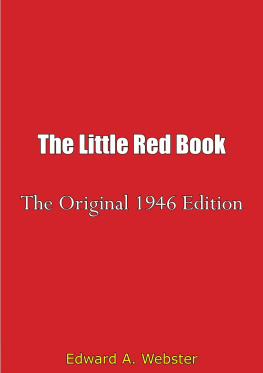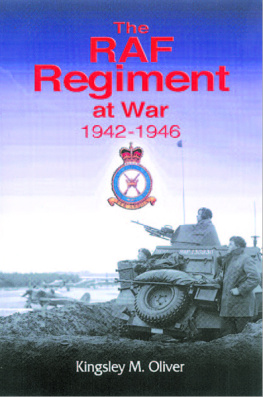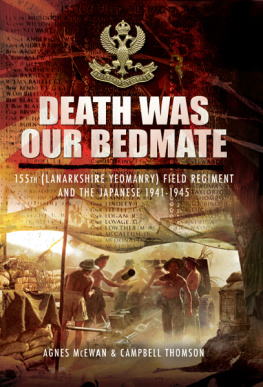First published in Great Britain in 2002 by
Leo Cooper
an imprint of Pen & Sword Books Limited
47 Church Street, Barnsley, South Yorkshire S70 2AS
Copyright 2002 by Kingsley M. Oliver
For up-to date information on other titles
produced under the Pen & Sword imprint,
please telephone or write to:
Pen & Sword Books Limited
FREEPOST
47 Church Street
Barnsley
South Yorkshire
S70 2BR
Telephone (24 hours): 01226 734555
ISBN 0-85052-852-6
PRINT ISBN: 9780850528527
PDF ISBN: 9781783377619
EPUB ISBN: 9781783379811
PRC ISBN: 9781783379613
All Rights Reserved. No part of this publication may be reproduced, stored in a retrieval
system or transmitted in any form or by any means; electronic, electrostatic, magnetic
tape, mechanical, photocopying, recording or otherwise, without permission in writing
from the publishers.
Kingsley Oliver has asserted his moral right to be identified as the author of this work.
A CIP catalogue record of this book is available from the British Library
Printed by CPI UK
ACKNOWLEDGEMENTS
As in any study of the events of the Second World War, the background and much of the detail has depended upon the official histories of the various campaigns, as published by Her Majestys Stationery Office. In addition to other material in the public domain in the Public Record Office, the Imperial War Museum, regimental archives and libraries, my researches have been enhanced by the published works of, among others, Chester Wilmot (The Struggle for Europe), Norman Gelb (Desperate Venture Operation Torch), FM Sir Bernard Montgomery (From Normandy to the Baltic), FM Sir William Slim (Defeat into Victory), Air Commodore Henry Probert (The Forgotten Air Force), Norman Franks (The Battle of the Airfields) and, of course, Squadron Leader Nicholas Tucker (In Adversity) for his definitive record of RAF Regiment honours and awards.
The personal reminiscences of those WWII veterans who have been kind enough to contribute letters, diaries and photographs have been extremely valuable and for similar material belonging to those now sadly deceased but which has been made available by their relatives, is equally appreciated by the author.
Accordingly, my thanks are due to Richard Auld, Ronald Gullen Beales, Charles Beddow, L Bowring, Douglas Burgiss, Norman Buckingham, ML Connolly, Dennis Cook, Roly Cooper (for his father, the late Gp Capt Stan Cooper), Richard Cox, Derrick Dean, Robert Edwards, CAG Eyles, Roland George, Graham Gow, Mark Hobden, Colin Hope, Ron House, Frederick Jeffrey, Maurice Jones, Charles Killeen, Arthur Langham, George Lawrence, Jim Lennon, WT McLellan, Randle Manwaring, A Mercer, Alex Miller, W Mitchell, Norman Parker, Bill Raymond, Len Read, Bernie Reid, DR Rescoe, Ronald Rollitt, Norman Salmon (for his father, the late Colonel Morrey Salmon), Peter Silk (for his father, the late Flt Lt Philip Silk), MJ Slee, Les Smith, J Smith, RT Statham, WD Stewart, Ted Stiles, Eric Westrope, Mike Williams and Frank Winfield.
I am grateful to the Trustees of the Imperial War Museum, Controller of Her Majestys Stationery Office and the Public Record Office for permission to reproduce photographs from their respective archives, and to Phil May for recapturing the action at Helmond in November 1944.
I am, as always, indebted to Air Vice-Marshal Donald Pocock for his wise counsel and for kindly writing the preface to this volume. I am grateful to Simon Hadley for his advice on design and for his skill in enabling small, old and often damaged photographs to be transformed into models of clarity. My sincere thanks also go to Squadron Leader Trevor Hadley for the unfailing support and encouragement which he has given in bringing the publication of this work to fruition. Finally, I record my appreciation for all my wife Audrey has done to assist me in this project.
Kingsley Oliver
Bromley, June 2002
PREFACE
By
Air Vice-Marshal D. A. Pocock CBE
Commandant-General RAF Regiment 1973-75
The loss of Crete to the Germans in 1941 confirmed, beyond all doubt, the vulnerability of our airfields to ground and air attack and the British government reacted with urgency to create a specialist airfield defence corps as an integral part of the Royal Air Force, designated as the Royal Air Force Regiment, which came into being at the beginning of 1942.
While the new force was being formed in the United Kingdom, officers and airmen already in overseas theatres were reorganized into RAF Regiment units and priority was given to the Middle East where the forward airfields, on which the Desert Air Force depended, were under attack from enemy ground and air forces. The successful conclusion of the North African campaign was followed by the invasions of Sicily and Italy, where the RAF Regiment continued to support air operations by defending RAF airfields against enemy ground and air attack, as well as by taking their place alongside Army units in the front line. RAF Regiment units were also engaged in operations against the Germans in the Balkans and in defeating the attempt to establish a communist regime in Greece. In the Far East the RAF Regiment enabled RAF aircraft to provide close support for the Army by operating from airstrips in the combat zone as the British steadily drove the Japanese out of Burma prior to the planned reoccupation of Malaya and Singapore. But the largest concentration of RAF Regiment forces was committed to North West Europe from D-Day onwards and played a major role in occupying and defending the airfields which the Second Tactical Air Force used as the Allied advance towards the German homeland brought the war in Europe to an end. Even at that late stage in the war the RAF Regiment played an important part in the home defence of the United Kingdom by deploying a large number of its anti-aircraft squadrons in the gun belt across southern England which, with fighter aircraft, countered the flying bomb assault which was intended to destroy London before Germany could be defeated.
At the end of the Second World War the RAF Regiment was little more than three years old but its achievements, in every part of the world in which the Royal Air Force operated against the enemy, had proved the essential contribution which its wings and squadrons made to the effectiveness of tactical air operations worldwide.
Its officers and airmen had learned their demanding trade quickly in the hard school of war, and the continuing existence of the RAF Regiment in the Royal Air Forces post-war order of battle is a tribute to the dedicated professionalism and courage of those who served in it from 1942 until the end of hostilities.
PROLOGUE
The only new thing in this world is the history you dont know
Harry S Truman (1884-1972) President of the USA 1945-1952
On the morning of 8 November 1942 some of the troopships of Convoy KM.1, loaded with the assault force for Operation Torch - the Anglo-American invasion of French North Africa hove to off the beaches at Ain Taya, twenty miles east of the port of Algiers. It was a cold, grey winters morning and the ships rolled in the stiffening breeze which was beginning to push the ocean swell into a foaming surf which broke ominously on the deserted shoreline. Flight Lieutenants Searle and Law, the respective commanders of Nos.4088 and 4089 Anti-Aircraft Flights of the RAF Regiment, surveyed the scene with some misgiving as their heavily-laden airmen clambered down the swaying cargo nets into the landing craft which bumped and swayed alongside the troopships.Their fears proved justified when the landing craft which had put them ashore found the sea too rough to load their stores and equipment for subsequent journeys from the ships to the beaches.







